History of OpenStreetMap
The OpenStreetMap project was founded in 2004 in the United Kingdom and has since grown into one of the largest open data projects on the Internet.
Project history
Steve Coast founded OpenStreetMap in 2004 while attending University College London. The initial focus was on the United Kingdom, where government-run and tax-funded projects like the Ordnance Survey created huge data sets, but failed to freely and widely distribute them. The first contribution was a street that Steve entered on 10 December 2004 after cycling around Regent's Park in London with a GPS receiver.[1][2][3] On 22 August 2006, the OpenStreetMap Foundation was established to encourage the growth, development and distribution of free geospatial data and provide geospatial data for anybody to use and share.
The volunteer mappers made edits to the OSM data using a java-based applet[4] on the OSM homepage or stand-alone “offline” programs supported by own surveys, self-recorded GPS traces and public-domain satellite imagery. One of those offline editors was JOSM which was constantly improved from then on and is still one of the most used editors. In December 2006, Yahoo confirmed that OpenStreetMap could use its aerial photography as a backdrop for map production. Half a year later, a new online data editor Potlatch appeared on the OSM homepage with the intention to make the start of new users easier.
Ways to import and export data have continued to grow; by 2008, the project developed tools to export OpenStreetMap data to power portable GPS units, replacing their existing proprietary and out-of-date maps.
In November 2010 the completely rewritten editor Potlatch 2 was made available and the use of Microsoft Bing vertical aerial imagery allowed for tracing. “Simple and friendly” is the concept of the new online editor iD, which appeared in May 2013.
Database history
OSM tracks the evolution of the map database change by change. You can inspect the revision history of an element using the Web frontend's built-in data browser or programmatically using the API. Various third-party OSM viewers summarize the revision history in a digestible format, such as OSM Deep History (tag changes only), OSM History Viewer (by PeWu) (tags and geometry), and Mapki's Deep Diff.
Ordinarily, a logical operation affecting the map requires changes to a number of elements in tandem, so the isolated history of an individual element may lack enough context to understand the operation. A changeset groups a mapper's changes by editing session, so that a logical operation is usually contained within a single changeset. Associated tags and discussion can give further context. Third-party tools such as Achavi and OSMCha allow you to visualize a changeset.
Mappers consider it good form to keep the history when performing operations on elements. However, splitting a way or merging two ways severs one way from its history, so editors try to preserve as much history as possible. In the past, when undeleting a way, Potlatch 1 would automatically add a history=* tag to help mappers track which version was undeleted, but this key has been deprecated and virtually eliminated from the database.
You can query a snapshot of the OSM database from a past date using the Overpass API (such as via Overpass turbo). The date setting allows you to access the attic data stored by Overpass (example).
To analyze the database's evolution at a larger scale, you can download a full planet dump and analyze it on the command line. taginfo's Chronology tab, OSM Tag History, and ohsome Dashboard track changes in tag usage trends over time.
Wiki history
This wiki also tracks its own history. See the MediaWiki guide to page history.
Timeline
Founding and early history
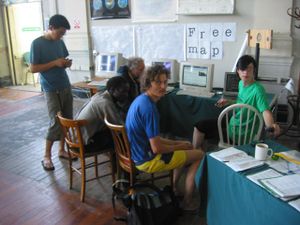
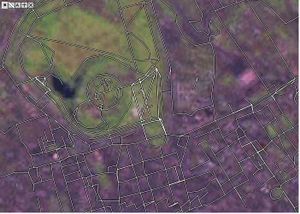
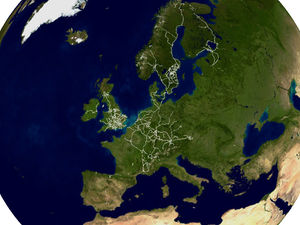
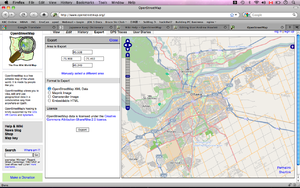
- 9th August 2004 – Domain openstreetmap.org registered by Steve Coast. In the following years this date is celebrated as OSM's birthday.
- 12th August 2004 – subversion First commit (an “import” from wherever(?)) to the OSM subversion program code repository of OpenStreetMap
- 16th August 2004 – The OSM website is up (also see more historic versions of the homepage)
- 20th August 2004 – Steve Coast presented his mapping idea at EuroFOO (summary by an attendee)
- 2nd September 2004 – First posting to the mailing list (then just 'openstreetmap', now 'talk')
- 7th September 2004 – The Java-plugin-based in-browser online editor, simply called “Java Applet”, was first added to the code.
- 6th October 2004 – Steve Coast uploads a description of how to contribute to OpenStreetMap (… at this time!)
- 10th December 2004 - First street entered.
- 11th December 2004 – A new version of the Java Applet went public at the openstreetmap.org homepage. New feature: you could add streets, yeah!
- 5th April 2005 – The Qt-based OSM editor osmeditor is uploaded to the OSM code repository by Nick Whitelegg.
- 24th April 2005 – Installation of MediaWiki which replaced the former PhpWiki
- 17th July 2005 – Map Limehouse, the first Mapping Party
- 27th August 2005 – Tom Carden uploads the code for a new applet, which replaces the old applet on the homepage at 4th September, 2005.
- 20th October 2005 – a high quality limited edition poster is produced and sold.
- Christmas Day 2005 – 1000th user registered
- 22nd January 2006 – Release of version 1.0 of the offline editor JOSM
- 27th January 2006 – opengeodata.org registered
- 17th March 2006 – First draft of the documentation page Map Features created
- 20th March 2006 – A osmarendered map of Weybridge is the first OpenStreetMap-based map to go on Wikipedia.
- 22nd March 2006 – OSM data is successfully fed back into a GPS device
- ▶ Take a journey into the past (23th April 2006) by watching an old JOSM introduction video about getting started with editing. You will also shortly see a part of the OpenStreetMap homepage at that time.
- 5th–7th May 2006 – IOW workshop, the first concentrated effort to map an area (and the first time many of the contributors met)
- 13th–14th May 2006 – Mapchester, the first collaborative mapping weekend in Manchester drawing in volunteers new to GPS and mapping
- 3rd July 2006 – Potlatch 1 alpha released.
- 12th August 2006 – 2nd OSM Anniversary Party, London
- 20th August 2006 – OpenStreetMap Foundation registered
- 31st August 2006 – 3000 registered users
- 10th November 2006 – Mapnik rendered slippy map makes its debut.
- 4th December 2006 – Yahoo! aerial imagery sketching allowed, which was removing the quasi contribution requirement of having a GPS device from mappers.
- ▶ Take a journey into the past (7th February 2007) by watching an video of the “Java Applet”(in case the playback does not work automatically, the downloadable .flv file could be played with e.g. VLC media player) about editing with help by the new aerial imagery.
(More historical milestones needed here, see discussion)
Origins of our current technology stack
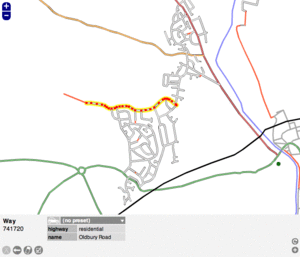
- 5th May 2007 – The Rails Port (thus named because the old Ruby-based API code was ported to Ruby on Rails) came online with API v0.4 as did the Potlatch editor on the openstreetmap.org homepage.
- 14th–15th July 2007 – First conference, "State Of The Map 2007", held in Manchester.
- 1st August 2007 – 5 million ways
- 7th August 2007 – 10,000 registered users
- 11th August 2007 – 3rd Anniversary Party, London
- 18th August 2007 – 100 million GPS points
- September 2007 – TIGER data import for the US started
- 20th September 2007 – AND Data for The Netherlands imported
- 7th October 2007 – Move to API v0.5 with segments dropped and relations added
- 18th November 2007 – 150 million GPS points and 100 million nodes
- 25th December 2007 – 20,000 registered users
- 8th January 2008 – 20 million ways
- 13th January 2008 – 200 million nodes
- 23th January 2008 – TIGER data import for the United States finished
- ▶ Take a journey into the past (February 2008 until January 2009) by watching Steve's OSM editing tutorial videos(in case the playback does not work automatically, the downloadable .flv file could be played with e.g. VLC media player).
- February 2008 – a series of workshops were held in India.
- 19th February 2008 – 25,000 registered users
- 12th–13th July 2008 – "State Of The Map 2008", held in Limerick, Ireland.
- 8th February 2009 – Map updates more than once a week
- 17th March 2009 – 100,000 registered users
New API 0.6, explosion of user growth and the license change
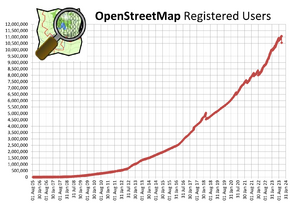
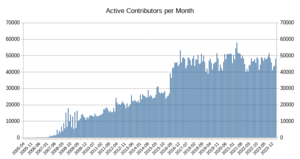
- 21st April 2009 – Big switch to API version 0.6 which introduces changesets
- 10th–12th July 2009 – "State Of The Map 2009", held in Amsterdam, the Netherlands.
- 25th August 2009 – Potlatch did not only have friends: there was the running gag to "ban Potlatch" (due to bad editing made by some of its – new – users using Potlatch's "live edit" mode) which even made its way into the node editing density history (visible in the USA area in a heatmap timelapse of node edits).
- 5th January 2010 – 200,000 registered users
- 13th January 2010 – Appeal for mappers launched after earthquake strikes Haiti. A detailed map is produced in 48 hours.
- 1st April 2010 – Ordnance Survey Opendata releases. OSM partly responsible for bringing this about.
- 9th–11th July 2010 – "State Of The Map 2010", held in Girona, Spain.
- November 2010 – One year after its first public version, the new editor Potlatch 2 was embedded into the openstreetmap.org homepage and set to be the new default editor another four months later.
- 30th November 2010 – Use of Bing vertical aerial imagery allowed
- 29th November 2011 – 500,000 registered users
- 9th–11th September 2011 – "State Of The Map 2011", held in Denver, Colorado, U.S.
- 29th August 2012 – 750,000 registered users
- 6th–8th September 2012 – "State Of The Map 2012", held in Tokyo, Japan.
- 12th September 2012 – License switched over to ODbL
- 23rd November 2012 – The map display of the openstreetmap.org homepage was switched from the OpenLayers to the Leaflet library
- 6th January 2013 – 1,000,000 registered users
New user interfaces and continued growth
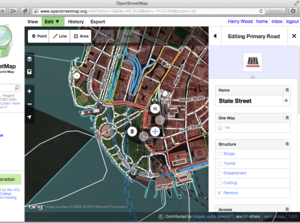
- 23rd Apr 2013 – Even unregistered users can now leave Notes on the map on www.openstreetmap.org to report problems!
- 7th May 2013 – Five months after its first public version, the new editor iD was embedded into the openstreetmap.org homepage and set to be the new default editor another three months later.
- 6th–8th September 2013 – "State Of The Map 2013" held in Birmingham, England.
- 2nd December 2013 – The www.openstreetmap.org website is completely redesigned.
- 14th January 2014 – 20,000,000th changeset.
- 9th August 2014 – Celebrations for the tenth anniversary of OpenStreetMap take place around the world
- 7th–9th November 2014 – "State Of The Map 2014" held in Buenos Aires, Argentina.
- 16th February 2015 – A routing feature was enabled on the www.openstreetmap.org website
- Spring 2015 – 2,000,000 registered users
- (State Of The Map 2015 was cancelled)
- 30th October 2015 – New road style of the standard map. Major changes to improve legibility and consistency of roads in the cartography.
- 16th March 2016 – The editor JOSM reaches version 10000 in its 10th year
- 23th–25th September 2016 – "State Of The Map 2016" held in Brussels, Belgium.
- 18th–20th August 2017 – "State Of The Map 2017" held in Aizu-Wakamatsu, Japan.
- 20 October 2017 – The DINAcon 2017 award for digital sustainability was awarded to longterm contributors.
- 16th June 2018 – The moderation queue was added to OpenStreetMap enabling users to report spam to moderators and administrators directly.
- 28th–30th July 2018 – "State of the Map 2018" held in Milano, Italy.
- 17th September 2018 – The first Data item was established. The system provides a semi-structured database of all tags.
- 8th November 2018 – Five Million registered users.
- 21st–23rd September 2019 – "State of the Map 2019" held in Heidelberg, Germany.
- 2nd July 2020 – Operations Working Group announces the retirement of Trac and Subversion in August. Both have been used for OpenStreetMap development for a very long time.
- 4th and 5th July 2020 – the first completely online "State of the Map" conference was held.
- 25th February 2021 – 100,000,000th changeset.
- 19th January 2023 – 10,000,000 registered users
See also
- News Archive — archive of news from this wiki's main page
- The event archive (2004-2020) contains all entries of OSM's wiki-based calendar
- Development activity for major software launches (out-of-date – currently showing 2004–2010)
- Category:Historic artifacts contains pages that refer to historically relevant wiki pages regarding OSM
- Moments in the history of OSM
- Statistics — more statistics showing the growing number of users and data elements
- Research — contains scientific analysis of OpenStreetMap's growth
- Major events in the years 2010–2013 by the Wochennotiz (in German)
- The official OSM blog still contains all the old entries (archive navigation on the left bottom)
- How a OSM-based map looked in 2008 (without USA; announcement)
- How a OSM-based map looked in 2012
- Before-after Map Generator (GitHub) – Compare OSM-based map for a given place and between a past year and the current date.
See also
Notes and references
- ↑ Coast, Steve (11 December 2004). “First street entered”. Retrieved 12 September 2024.
- ↑ Fox, Killian (18 February 2012). “OpenStreetMap: 'It's the Wikipedia of maps'”. The Guardian. London. Retrieved 12 September 2024.
- ↑ Changeset 1 (achavi, OSMLab, FacilMap) is often cited as the first contribution, but this changeset is dated 9 April 2005 and only contains deletions, implying the existence of earlier data. The concept of changesets was introduced in April 2009, at which point existing edits were grouped into synthetic changesets, not necessarily in chronological order. Earlier contributions from 2004 and 2005 are unfortunately unavailable. Early changesets are further impacted by the elimination of segments in October 2007, though former segments are still accessible in some early planet dumps.
- ↑ see the history of that page: https://wiki.openstreetmap.org/w/index.php?title=Editing&oldid=10792